Casualties
Key Developments
Recorded mine/ERW/IED casualty rates continued their steady decrease in 2007, but the decrease was markedly less significant than in previous years. Also, in 2007-2008, casualties occurred in several countries where none had ever been recorded before or not for several years. Despite the crucial need for appropriate and comprehensive casualty data collection mechanisms, little or no progress was identified during the reporting period in terms of coverage, accuracy, and usage of casualty data.
Casualties in 2007 by status
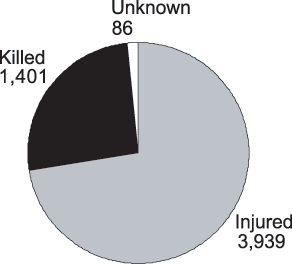
Landmine/ERW/IED Casualties in 2007
In 2007, Landmine Monitor identified 5,426 casualties caused by mines, explosive remnants of war (ERW), and victim-activated improvised explosive devices (IEDs). Of these, 1,401 people were killed, 3,939 injured, and the status of the remaining 86 is unknown.[1] These figures are by no means complete as they only include recorded casualties plus casualties Landmine Monitor was able to identify through the media. In 2006, at least 6,022 casualties were reported in 71 countries and areas.[2] As in 2006, the number of casualties decreased by 9% in 2007,[3] although casualties will continue to be identified due to slow data collection (for example, in the DRC and Sudan) and problems with data management (for example, in Angola and Sri Lanka).
Despite the decreased casualty totals, casualties have never been recorded in as many states and other areas as in 2007-78 (see table below). Thirteen countries[4] recorded casualties in 2007 where there had been none in 2006 (167 total casualties); and two countries had never before recorded casualties: the Gambia and Mali. Other countries had not recorded casualties for several years, for example Niger. The casualties in these three countries were all due to new antivehicle mine use.
States and other areas with mine/IED/ERW casualties in 2007
|
Africa |
Americas |
Asia-Pacific |
Europe |
CIS |
Middle East and North Africa |
|
Angola |
Chile |
Afghanistan |
Albania |
Armenia |
Algeria |
|
Burundi |
Colombia |
Cambodia |
BiH |
Azerbaijan |
Egypt |
|
Chad |
El Salvador |
China |
Croatia |
Belarus |
Iran |
|
Côte d'Ivoire |
Honduras |
India |
France |
Georgia |
Iraq |
|
DRC |
Nicaragua |
Indonesia |
Latvia |
Kyrgyzstan |
Israel |
|
Eritrea |
Peru |
Lao PDR |
Poland |
Russia |
Jordan |
|
Ethiopia |
US |
Mongolia |
Serbia |
Tajikistan |
Kuwait |
|
Gambia |
Myanmar |
Turkey |
Ukraine |
Lebanon |
|
|
Guinea-Bissau |
Nepal |
Kosovo |
Abkhazia |
Morocco |
|
|
Kenya |
Pakistan |
Nagorno-Karabakh |
Syria |
||
|
Mali |
Philippines |
Yemen |
|||
|
Mauritania |
South Korea |
Palestine |
|||
|
Mozambique |
Sri Lanka |
Western Sahara |
|||
|
Namibia |
Thailand |
||||
|
Niger |
Vietnam |
||||
|
Rwanda |
|||||
|
Senegal |
|||||
|
Somalia |
|||||
|
South Africa |
|||||
|
Sudan |
|||||
|
Uganda |
|||||
|
Zambia |
|||||
|
Zimbabwe |
|||||
|
Somaliland |
|||||
|
23 states |
7 states |
15 states |
8 states |
8 states and |
11 states and |
Total recorded casualties by year

Casualty demographics
As in previous years, civilians made up the vast majority of casualties where the civilian/military status was known: 71%. Since 2005, however, the percentage of civilian casualties has decreased by 10%. This is partly due to the continuing high number and increasing percentage of casualties among security forces in Colombia (697 in 2007). If Colombia is excluded, military casualties would only account for 13% of casualties whose status is known and not 27%. Also, data for many military casualties were recorded through the media, which tend to focus on security forces killed in conflicts abroad (particularly in Afghanistan and Iraq) or on major incidents causing multiple military casualties (for example in India Pakistan, and Somalia) while neglecting civilian casualties. Casualties among non-state armed groups (NSAGs) are typically under-reported but were identified in Afghanistan, Colombia, Iraq, Myanmar, and Palestine in 2007.
There was also a significant increase in humanitarian demining casualties in 2007 (120, up from 69 in 2006), partly due to an increase in the number of accidents in Lebanon. Among clearance casualties there were six women (in Afghanistan and Cambodia).
Males were the largest casualty group where the gender was known (89%, 3,930); females accounted for 11% of total casualties where gender was known (467). For 19% of casualties, however, the gender was unknown (1,029). Among civilian casualties alone, the percentage of female casualties was higher, at 16% (452). In general, females were at less risk than males but, in some countries, specific livelihood activities put them at particular risk (for example, tending animals in Yemen or collecting wood/water in DRC). The number of male casualties also has an indirect impact on women, as in many traditional societies males are the primary income earners, and female-headed households are generally poorer.
Children accounted for 31% of total casualties where the age was known but, more significantly, this percentage grew to nearly half of the civilian casualties (46%). For child casualties where gender was known, 82% (976) were boys and 18% (213) were girls.
Among civilian casualties where age and gender were known, men were the largest casualty group (48%), followed by boys (36%), and women and girls (8% each). In a few countries, boys were the largest single casualty group: Chad, Kosovo and Lao PDR.
Casualties in 2007 by civilian/military status

Casualties in 2007 by gender
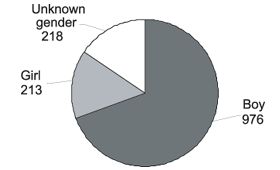
Casualties in 2007 by age
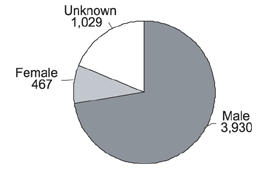
Child casualties in 2007 by gender
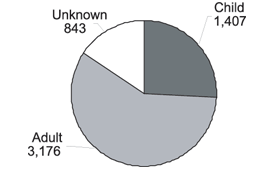
Devices causing casualties[5]
For nine out of every 10 casualties the device causing the incident was known. Of these:
- 1,440 were caused by ERW other than (cluster) submunitions (36.3%),
- 987 by antipersonnel mines (24.9%),
- 502 by antivehicle mines (12.6%),
- 452 by unspecified mines (11.4%),
- 372 by victim-activated IEDs (9.4%), and
- 216 by submunitions (5.4%).
Different demographics are affected differently by each device type. For antipersonnel mine casualties, 74% were adults and 26% were children. Of the adult antipersonnel mine casualties, 89% were male, including 51 deminers. For antivehicle mine casualties, 80% were adults. The only device where the adult-child distribution was roughly equal was submunitions (48% children, 52% adults). This picture is skewed by Lebanon where, due to clearance and high-risk activities undertaken out of economic necessity, the number of adult casualties was significantly higher than in other submunition-affected countries. For countries significantly affected by submunitions and where the contamination has been present for many years, children were generally the majority casualty group in 2007, for example in Afghanistan, Cambodia, Iraq, Lao PDR, and Vietnam.
Casualties in 2007 by age and device

Casualties in 2006‚2007 by country
(largest diferences)
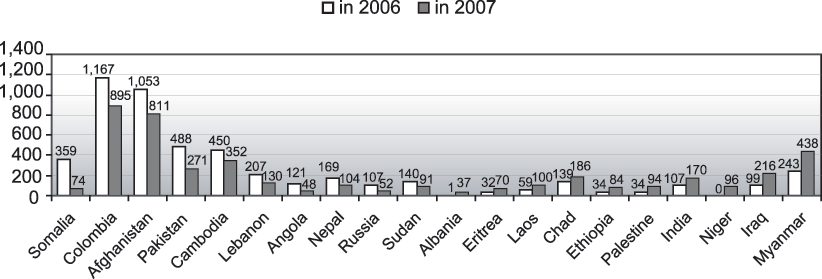
Children (mainly boys) were nearly 60% of total ERW casualties but only 20% of mine casualties. Among civilian ERW casualties, boys accounted for 49%, men 31%, girls 12%, and women 8%. This was also the only device category where girls accounted for significantly more casualties than women.
ERW casualties (excluding submunition casualties) were reported in 54, antipersonnel mine casualties in 37, antivehicle mine casualties in 23, victim-activated IED casualties in 13, and submunition casualties in 12.
Activity at time of incident
Collecting information on the activity at the time of the incident, although crucial for mine/ERW risk education purposes, is the weakest component of data collection. That said, it appears that civilian casualties occur mostly in rural areas as people go about their daily livelihood activities, often driven by economic necessity to go into areas they know to be dangerous, as in Lebanon and Vietnam. These livelihood activities can include scrap metal collection, which is a significant cause of casualties in Lao PDR, Iraqi Kurdistan, Nicaragua, and Peru.
New antivehicle mine/IED contamination did mark a shift in activities causing casualties in some places, for example in southern and southeastern Afghanistan where there was a marked increase in the number of casualties caused while traveling (20% up from 10%). Similarly, traveling was the most frequent cause of incidents resulting in new casualties in Niger.
Regional distribution
Casualties occurred in all major regions but only increased in Europe and the Middle East and North Africa:
- 2,448 casualties in 15 countries in Asia-Pacific (down from 2,768 in 14 countries);
- 973 in seven countries in the Americas (down from 1,194 in five countries);
- 944 casualties in 24 countries/areas in Africa (down from 1,153 in 20 countries/areas);
- 689 in 13 countries/areas in the Middle East North Africa (up from 532 in 13 countries/areas);
- 238 in nine countries/areas in Europe (up from 167 casualties in nine countries/areas);
- 134 casualties in the 10 countries/areas in the Commonwealth of Independent States (down from 208 in 11 countries/areas); and
- Among VA25 countries just three (Afghanistan, Cambodia and Colombia) accounted for 38% of casualties (compared to 44% in 2006).[6]
Of the 65 countries recording casualties in both 2006 and 2007, 29 reported lower casualty rates in 2007 and three the same number. The overall decrease of casualties is largely due to the significant decreases in a few severely-mine-affected countries.
- Afghanistan: 811 down from 1,053 (due to clearance, but also under-reporting in conflict areas);
- Cambodia: 352 down from 450 (ascribed to mine/ERW risk education, sanctions on scrap metal trade, and increased community involvement in mine action);
- Colombia: 895 down from 1,167 (due to increased government control); and
- Lebanon: 130 down from 207 (due to the emergency situation in 2006).
Trends in states with 100 or more casualties in 2007
|
Country |
Casualties in 2007 |
|
Colombia |
895 (-) |
|
Afghanistan |
811 (-) |
|
Myanmar |
438 (+) |
|
Cambodia |
352 (-) |
|
Pakistan |
271 (-) |
|
Iraq |
216 (+) |
|
Chad |
186 (+) |
|
India |
170 (+) |
|
Lebanon |
130 (-) |
|
Vietnam |
110 (+) |
|
Nepal |
104 (-) |
|
Turkey |
101 (+) |
|
Lao PDR |
100 (+) |
In other cases a decrease was due to a lack of data coverage in some areas in 2007 compared to the previous year:
- Angola: 48 down from 121,
- Sri Lanka: 34 down from 64, and
- Uganda: 23 down from 50.
However, 33 countries recorded higher casualty levels, including:
- Chad: 186 up from 139 (due to escalating conflict);
- Iraq: 216 up from 99 (partly due to better data collection but also better media reporting); and
- Myanmar: 438 up from 243 (due to increased conflict).
In two countries particularly, improved data collection was the reason for increased casualty figures. For example, in Eritrea there were 70 casualties in 2007, up from 32 in 2006; and in Ethiopia there were 84, up from 34 (partly due to one-off survey activity).
Casualties continued to be recorded in 2008 with at least 61 countries recording casualties until August 2008, including three countries that did not have casualties in 2007 (Cyprus, Djibouti, and Libya). Some countries reported higher totals to August 2008 than for the entire calendar year 2007, such as BiH, Côte d'Ivoire, Jordan, Senegal, and Sri Lanka. Cluster munitions were used in the conflict between Georgia and Russia. Landmine Monitor does not include casualties that occur during strikes in casualty totals, but only those from submunitions that failed to explode upon impact. According to Human Rights Watch, at least two civilians were killed and five more injured as a result of unexploded submunitions in August 2008, but exact numbers were not known as Landmine Monitor went to print.
Data Collection
Obtaining comprehensive data on mine/ERW/IED casualties for mine action planning purposes remained challenging and no improvement in this situation was observed in 2007. Of the 78 states and areas with casualties in 2007, 48 had data collection mechanisms and 32 used the Information Management System for Mine Action (IMSMA) nationally or regionally to store that data. This means that a quarter of casualties (1,358) occurred in countries/areas without a formal data collection mechanism (up from 19% in 2006). The vast majority of casualties in these countries were identified through the media and therefore data was incomplete. The most notable examples are: Algeria (78 casualties), India (170), Iran (40), and Pakistan (271). In a few cases field operators provided casualty data to Landmine Monitor, but no standard or unified data collection mechanism existed, for example in Myanmar where 249 of 438 casualties were reported by field operators.
However, the existence of casualty data collection mechanisms does not mean that these data are complete. Landmine Monitor identified only three countries/areas where casualty data can be considered complete: BiH, Cambodia and Jordan. They accounted for 392 casualties (7% down from 8%); meaning that 93% of casualties were recorded in countries with an incomplete or no data collection mechanism (92% in 2006). Landmine Monitor found additional casualties in 25 of 48 countries with data collection mechanisms (774 casualties in total).
[1] These figures include individuals killed or injured in incidents involving devices unintentionally detonated by the presence, proximity, or contact of a person or a vehicle, such as all antipersonnel mines (whether factory- or home-made), antivehicle mines, unexploded ordnance, abandoned explosive ordnance, and victim-activated IEDs. Not included in the totals are: estimates of casualties where exact number is not given; incidents clearly caused by remote-detonated mines or IEDs; and devices that were not clearly victim activated. For some countries, such as Iraq, where verification of reported incidents was particularly difficult, even stricter criteria were applied as IED incidents were only included if the device was set off by direct (hand or foot) contact.
[2] In its previous report Landmine Monitor identified 5,751 casualties in 68 states/areas in 2006. However, due to slow data collection new casualties occurring in 2006 were identified in four other states (Albania, China, El Salvador, and Moldova). Several countries also sent revised casualty totals, and database analysis in Afghanistan identified 257 additional casualties.
[3] In 2005, 6,873 casualties were recorded.
[4] Côte d'Ivoire, France, the Gambia, Honduras, Israel, Kenya, Mali, Mongolia, Niger, Serbia, South Africa, United States, and Zambia.
[5] The figures dealing with device type in this section exclude Colombia as the data is not detailed enough to merit inclusion.
[6] At the First Review Conference, from 29 November-3 December 2004, 23 States Parties declared responsibility for significant numbers of survivors, and "the greatest responsibility to act, but also the greatest needs and expectations for assistance" in providing adequate services for the care, rehabilitation and reintegration of survivors: Afghanistan, Albania, Angola, BiH, Burundi, Cambodia, Chad, Colombia, Croatia, DRC, El Salvador, Eritrea, Guinea-Bissau, Mozambique, Nicaragua, Peru, Senegal, Serbia, Sudan, Tajikistan, Thailand, Uganda, and Yemen. With Ethiopia's ratification of the Mine Ban Treaty on 17 December 2004, the number increased to 24 and at the Eighth Meeting of States Parties in November 2007, Jordan also declared it was responsible for significant numbers of survivors, making it the 25th State Party in this group.





